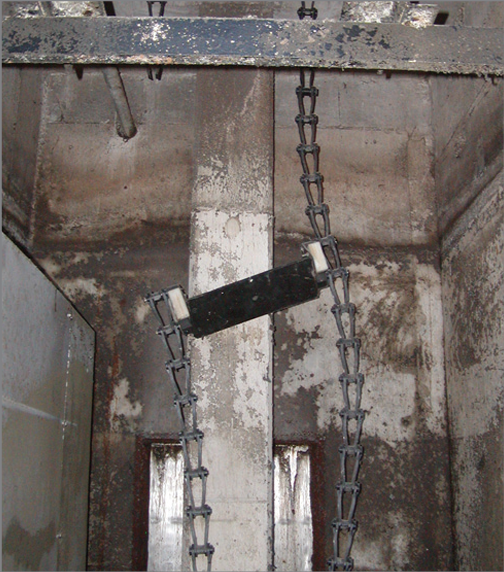Joliet Westside Wastewater Treatment Plant - Grit Collector
THE SITUATION
They say a picture is worth a thousand words. Such is the case with the picture (right) of the broken plastic chain on a grit collector, which tells a lengthy and costly story of good intentions gone bad. Several years ago, in an effort to reduce expensive maintenance on old corroding cast iron chain, a Joliet, Illinois wastewater treatment plant chose plastic chain as an inexpensive, easy-to-work-with replacement. At the time, plastic was lighter for staff to handle, and less expensive than many other materials on the market. Initially, it was a much needed improvement over the cast iron. However, “there were loads of problems with the plastic chain almost as soon as we put it in,” notes Mark Paskvan, Chief Operator at the Joliet Westside Wastewater Treatment Plant in Illinois.
While plastic is a satisfactory equipment material, the stresses of extreme conditions in the Illinois climate, and at the Joliet plant in particular, were more than it could handle. First, Joliet sees extremes in hot and cold temperatures which expand and contract plastic, weakening it. Second, the high amount of abrasive sediment in the grit collector environment was too abrasive for this type of injection-molded plastic, causing further weakness. Third, grit collectors have high workload requirements, often exceeding the rated working load of plastic chain, which was the case at Joliet.
This combination of weather, abrasion, and workload attacked the plastic chain, causing breakage soon after installation. Trying to save their investment, Mark remembers, “We had to visually inspect the chain to try to catch weaknesses in the plastic before breakage,” noting that the inspection activity added to maintenance costs. But breakages, such as the one pictured, were also costly, often consuming 48 man hours at a time to repair. Despite their best efforts to be proactive, it was common for the plastic grit collector chain to break every three to six months. What started out as being a welcomed improvement over cast iron chain ended up being substantially more expensive in labor, maintenance, and replacement.
BEFORE TREATMENT
Broken plastic chain on grit collector
THE SOLUTION
In an effort to find a permanent solution to the costly and ongoing grit collector chain problems, one of the staff asked Mike Humcke of Environmental Resources, Inc., for some suggestions. Mike, who happened to be at the plant inspecting a chain he had installed for the plant’s bar screen, was holding the answer in his hand: the same cast stainless steel chain he had used on the bar screen would work on the grit collector. In fact, Mike had made the chain originally for the more extreme conditions encountered in grit collection. “I told them I made the chain for just such a situation,” Mike said, “For extreme-duty, corrosive and abrasive environments with high workload demands.” Mike’s own frustrations as a 30-year wastewater industry veteran and engineer had led him to develop a chain that would solve the problems his clients regularly encountered, ones identical to those in the grit collectors at Joliet. In 2004, working with a metallurgist and a casting specialist, Mike succeeded in casting aerospace-grade stainless steel into a line of products for wastewater equipment called DuraMax.
“It’s reliable. It just runs and takes care of itself.”
Both his design and manufacturing methods produced high strength chain that eliminates nearly all wear and strength loss caused by corrosion and abrasion. With specially formulated alloys, the chains are also ideally suited to resist attack from a wide range of chemical and biological compounds, and temperature extremes. The result? A chain with a life of 20+ years. Mike is so confident in the performance of his chain that he offers a 10year full replacement guarantee, even when the chain is used in severe- and extreme-duty environments. Presented with these facts, Joliet chose the DuraMax chain for one of their grit collectors in 2008, and have never looked back.
“It’s reliable,” says Mark, “It just runs and takes care of itself,” visually relieved at having ended their recurring and expensive cycle of chain replacement. Mark noted that no breakage has occurred since the chain’s installation. In fact, in 2010, they are retrofitting an additional two grit collectors with the DuraMax chain.
RESULTS
Equipment
- Plastic chain on chain-and-bucket grit collector broke 3 to 6 times per year, resulting in expensive equipment replacement
- Plastic chain has no guarantee
- Chain has worked fine with no need for replacement
- Design life of 20 years will save the Joliet facility $86,000 over the life of the chain for labor on chain maintenance alone
- Standard 10-year guarantee gives Joliet no-cost peace of mind
Man Hours
An average of 144 man hours needed per year for maintenance of plastic chain
Joliet has saved 288 total man hours since 2008, and counting. Have not had to make a repair since installation.
Maintenance
- Visual inspections needed to detect wear and corrosion to try and avoid catastrophic breakages
- Even with increased inspection, chains still broke regularly, resulting in labor intensive service outages
- Reduced cost by:
- Eliminating visual inspections
- Eliminating cost needed to replace chain
- Eliminating cost needed to fix chain
Operations
Operations would be routinely interrupted to accommodate needed chain repair or replacement
Chain takes care of itself with virtually no significant maintenance needed



